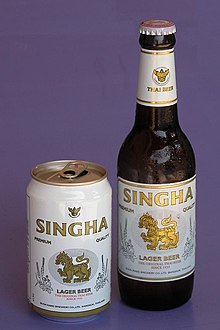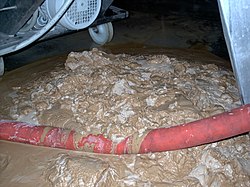Bright beer

Filtered or bright beer is beer in which yeast is no longer in suspension. There are several methods used for clearing yeast from beer, ranging from passively waiting for the yeast to drop of its own accord (dropping bright) to actively removing it (filtering).
Dropping bright
When the concentration of fermentable sugars in the beer falls below a certain level, variable with the strain of yeast, the yeast cells will naturally flocculate and settle toward the bottom of the vessel in which the beer is stored; this act is known as dropping bright. The degree to which yeast flocculates is dependent on many factors, including the specific gravity of the beer, the gas pressure over the beer, the ambient temperature, and some biological properties particular to the yeast strain; some beers will never drop bright by themselves.
Some breweries make available rack bright beer, which is cask-conditioned beer that has been dropped bright at the brewery and then racked, transferred, to a new container for shipment. Rack bright beer generally costs slightly more than ordinary beer, all else being equal, but requires less preparation time and care at the point of serving; in particular, dropping bright requires that the beer be left undisturbed to settle, as jarring or shaking its container will re-suspend the yeast.
Any beer which has been dropped bright or fined will have a layer of yeast sediment at the bottom of its storage vessel.
Fining
Finings can be introduced during the production of beer in order to induce it to drop bright more readily. For British beers, the most common fining agent is isinglass, and most breweries producing Real Ale introduce isinglass into the shipment cask so that the beer will drop bright readily upon the cask's being breached; this process can take from several hours to two or three days and may require the addition of supplementary finings by the cellarman.
Filtration
In contrast to dropping bright, yeast may also be removed from beer through filtration.
Filters range from rough filters that remove much of the yeast and any solids (e.g. hops, grain particles) left in the beer, to filters tight enough to strain color and body from the beer. Normally used filtration ratings are divided into rough, fine and sterile. Rough filtration leaves some cloudiness in the beer, but it is noticeably clearer than unfiltered beer. Fine filtration yields a beer which is nearly transparent and not cloudy, although observation of the scattering of light through the beer will reveal the presence of some small particles. Finally, as its name implies, sterile filtration is fine enough that almost all microorganisms in the beer are removed during the filtration process. Beer which has been filtered is usually held in bright tanks at the brewery before bottling or additional treatment.
Filtration is the norm for beers brewed in Germany and much of the rest of continental Europe. Mass-produced lagers worldwide are universally sterile filtered as well, as are beers packaged for kegging.
In the UK a beer which has been filtered in the brewery is known as brewery conditioned beer. A brewery conditioned beer may simply be filtered, or it may also be pasteurised. The term is used to differentiate such beers from those which are still in contact with the yeast which are known as bottle conditioned, cask conditioned or real ale.
Sheet (pad) filters
Sheet filters use pre-made media and are relatively straightforward. The sheets are manufactured to allow only particles smaller than a given size through, and the brewer is free to choose how finely to filter the beer. The sheets are placed into the filtering frame, sterilized (with hot water, for example) and then used to filter the beer. The sheets can be flushed if the filter becomes blocked, and usually the sheets are disposable and are replaced between filtration sessions. Often the sheets contain powdered filtration media to aid in filtration.
Pre-made filters have two sides: one with loose holes, and the other with tight holes. Flow goes from the side with loose holes to the side with the tight holes, with the intent that large particles get stuck in the large holes while leaving enough room around the particles and filter medium for smaller particles to go through and get stuck in tighter holes.
Sheets are sold in nominal ratings, and typically 90% of particles larger than the nominal rating are caught by the sheet. For sterile filtration, a typical size is 1 micrometre.
Kieselguhr filters

Filters that use a powder medium are considerably more complicated to operate, but can filter much more beer before needing to be regenerated. Common media include diatomaceous earth, or kieselguhr, and perlite.
Cold Filtering
Contrary to popular belief, all beer filtration is done cold. When beer is chilled the protein molecules tend to clump together and so are easier to filter out. When breweries advertise the words "cold-filtered" on their cans or bottles, it is simply a marketing gimmick used to differentiate the beer from those that have been heat pasteurized.[1]
See also
References
- ^ Garrett Oliver, The Brewmaster's Table, page 19.
